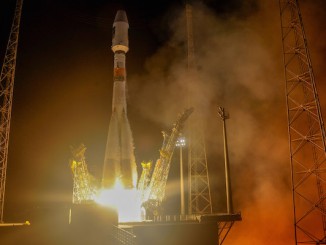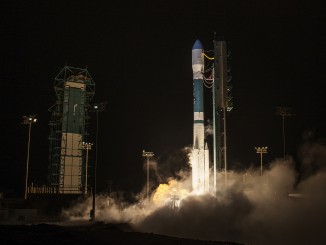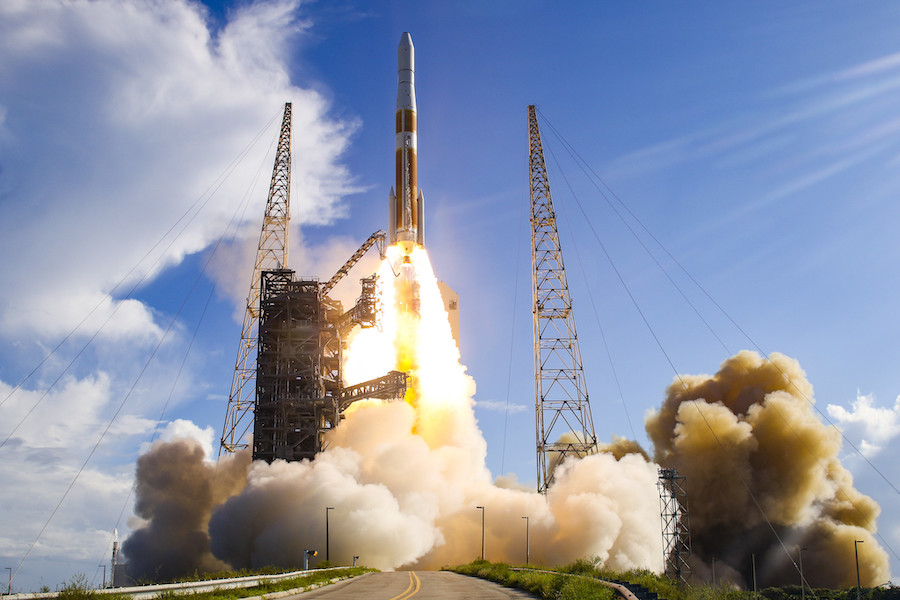
The last Delta 4 launcher to fly in a single-core configuration rumbled into space Thursday morning from Cape Canaveral with a GPS navigation satellite, leaving United Launch Alliance with five more Delta 4-Heavy missions on contract through late 2023 before the Delta rocket family retires from service.
ULA’s final mission using a Delta 4-Medium rocket, which is powered by a single first stage booster core, lifted off at 9:06 a.m. EDT (1306 GMT) Thursday from Cape Canaveral’s Complex 37 launch pad.
The core stage’s RS-68A main engine, made by Aerojet Rocketdyne, ignited in a ball of fire five seconds before liftoff and throttled up for a computer-controlled health check. Moments later, twin Northrop Grumman-built solid rocket motors flashed to life and three swing arms quickly moved out of the way as the 207-foot-tall (63-meter) Delta 4 climbed away from pad 37 and headed northeast over the Atlantic Ocean with more than 1.2 million pounds of thrust.
Less than two hours later, after a pair of on-target burns by the Delta 4’s second stage RL10 engine, the launcher deployed the U.S. Air Force’s 8,170-pound (3,705-kilogram) GPS 3 SV02 spacecraft into an elliptical transfer orbit stretching more than 12,500 miles (nearly 20,200 kilometers) above Earth.
Officials declared success after the spacecraft separated from the launcher, and ground teams at Lockheed Martin — the satellite’s manufacturer — established contact with the GPS network’s newest member to begin a series of post-launch commissioning and checkout steps.
With the successful conclusion of Thursday’s mission, the Delta 4-Medium rocket family retired with an unblemished record over 29 launches since the first Delta 4 flight Nov. 20, 2002.
ULA is phasing out the Delta 4-Medium as the company faces stiff competition from SpaceX for U.S. military launch contracts. The new Vulcan Centaur rocket, set for an inaugural launch in 2021, will be less expensive than than the Atlas and Delta rockets it will replace, according to ULA.
“Thank you to the team and our mission partners for the tremendous teamwork as we processed and launched this critical asset, providing advanced capabilities for warfighters, civil users, and humankind across the globe,” said Gary Wentz, ULA vice president of government and commercial programs, in a statement. “We are proud of the strong legacy of the Delta 4-Medium program, and look forward to the future with our purpose-built Vulcan Centaur.”
The Delta 4-Heavy rocket, made by combining three Delta 4 first stage cores together, will continue flying through 2023. ULA’s Atlas 5 rockets, which cost less than the Delta 4 but more than SpaceX’s Falcon 9, will also remain operational through the early-to-mid 2020s.
“We made a business decision a few years ago that we would transition from the Delta 4 and Atlas vehicles over to a Vulcan Centaur, purpose-built to satisfy the entire mission suite, so it was time for us to phase out the Delta 4-Medium at this point,” Gary Wentz said in a pre-launch press briefing. “We don’t see any specific payloads that would require the Delta 4-Medium that we can’t fly on an Atlas 5.”
The five Delta 4-Heavy missions left in ULA’s backlog will all haul top secret payloads into orbit for the National Reconnaissance Office, the U.S. government’s spy satellite agency. Those payloads are too heavy to fly on the Atlas 5.
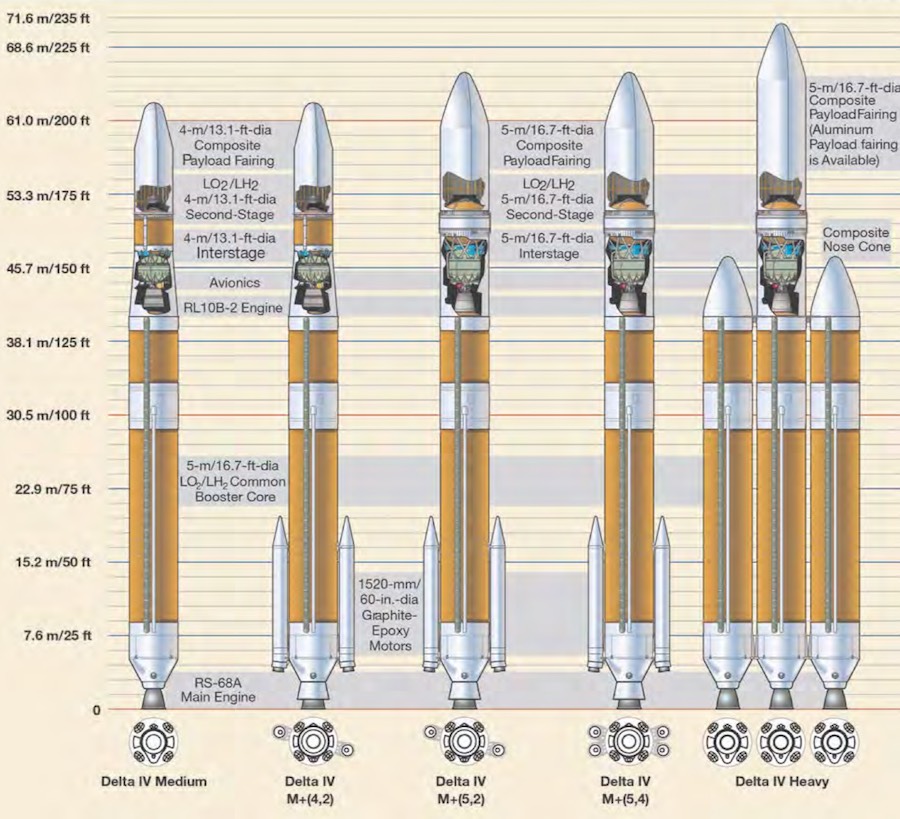
The next Delta 4-Heavy launch, codenamed NROL-44, is scheduled for June 2020 from Cape Canaveral, ULA and Air Force officials said. ULA teams will prepare a second Delta 4-Heavy launcher for liftoff on the NROL-82 mission in September 2020 from Vandenberg Air Force Base, California.
Three more Delta 4-Heavy missions are set for launches in 2022 and 2023, two from Cape Canaveral, and one from Vandenberg. Here is the Delta 4-Heavy’s launch manifest, based on information provided to Spaceflight Now within the last week by the Air Force and ULA:
- Delta 4-Heavy with the NROL-44 payload
- Launch Date: June 2020
- Launch Site: SLC-37B, Cape Canaveral Air Force Station, Florida
- Delta 4-Heavy with the NROL-82 payload
- Launch Date: September 2020
- Launch Site: SLC-6, Vandenberg Air Force Base, California
- Delta 4-Heavy with the NROL-91 payload
- Launch Date: 2022
- Launch Site: SLC-6, Vandenberg Air Force Base, California
- Delta 4-Heavy with the NROL-68 payload
- Launch Date: 2022
- Launch Site: SLC-37B, Cape Canaveral Air Force Station, Florida
- Delta 4-Heavy with the NROL-70 payload
- Launch Date: Late 2023
- Launch Site: SLC-37B, Cape Canaveral Air Force Station, Florida
ULA received a sole source request for proposals for the latter three Delta 4-Heavy missions in 2017. An Air Force spokesperson told Spaceflight Now that the Delta 4-Heavy “is the only launch vehicle with the unique capabilities to meet the NRO’s requirements and launch dates.”
SpaceX’s Falcon Heavy rocket, which the Air Force certified for national security launches last year, can lift heavier cargo into space than ULA’s Delta 4-Heavy, and at a fraction of the cost. The Air Force last year awarded SpaceX a $130 million contract for a Falcon Heavy launch, less than half the current price of a Delta 4-Heavy.
The “unique capabilities” needed for the NRO missions may include the Delta 4-Heavy’s larger fairing volume, and ULA’s ability to integrate payloads in a vertical orientation, according to industry sources. The design of some exquisite national security payloads require vertical integration on their launch vehicle, while SpaceX installs payloads on their rockets horizontally.
“We’re continuing to fly the Delta 4-Heavy through the latter part of 2023 for specific payloads that require that capability and mission success assurance that we provide,” Wentz said. “We’ll continue to fly those as long as the customer sees the need, and we have planned an on-ramp for Vulcan Centaur to provide us some overlap with that capability to give some additional redundancy to all our customers.”
Future heavy-lift missions — known as Category C payloads in the Air Force’s parlance — will be part of the military’s ongoing competition to select new launch vehicles for national security satellites starting in the early-to-mid 2020s, and will not be sole-sourced, an Air Force spokesperson said.
The Delta 4 launcher was originally designed and developed by Boeing in the 1990s. The Atlas 5 was conceived by Lockheed Martin.
The competing aerospace contractors merged their launch divisions in 2006, marking the birth of ULA as a 50-50 joint venture. ULA kept the the Atlas and Delta rocket lines operational to ensure the U.S. military had two independent launch options for national security satellites, a cornerstone tenet of the Air Force’s assured launch procurement strategy.
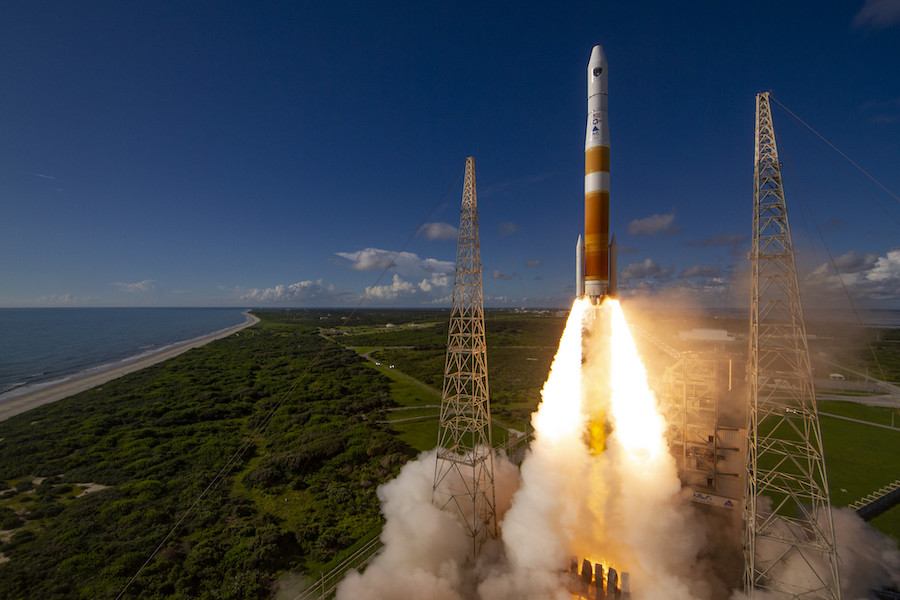
But SpaceX’s Falcon 9 and Falcon Heavy rockets are now certified to launch U.S. national security payloads. With the Falcon and Atlas rocket families, the military will continue to have two launch options after the Delta 4-Medium’s retirement.
The Delta 4 that launched Thursday flew in the “4,2” configuration with a 4-meter (13.1-foot-diameter) payload fairing and two 53-foot-long (16-meter) strap-on solid rocket boosters. With the retirement of the Delta 4-Medium variant, the Delta 4’s solid rocket boosters — designated GEM-60s — and 4-meter fairing flew for the final time Thursday.
Delta rockets started launching in 1960, but today’s Delta 4 rocket bears little resemblance fo the Delta boosters from the early days of the space program. Thursday’s launch was the 384th flight of a Delta vehicle.
The Lockheed Martin-built GPS satellite separate from the Delta 4 launcher at 11:01 a.m. EDT (1501 GMT) Saturday, and ground teams soon began communicating with the spacecraft.
The GPS 3 SV02 navigation satellite, nicknamed “Magellan,” will use its own engine to circularize its orbit and join the GPS constellation some 12,550 miles above the planet, where ground teams will test the new spacecraft and put it into service to replace an aging member of the constellation.
“GPS 3 SV02 is receiving and responding to commands just as planned,” said Johnathon Caldwell, Lockheed Martin’s vice president of navigation systems. “In the days ahead, we’ll finish orbit raising to our operational slot and then send the satellite commands telling it to deploy its solar arrays and antennas.
“Once we are set up, we’ll begin on-orbit checkout and tests, including extensive signals testing with our advanced navigation payload,” Caldwell said.
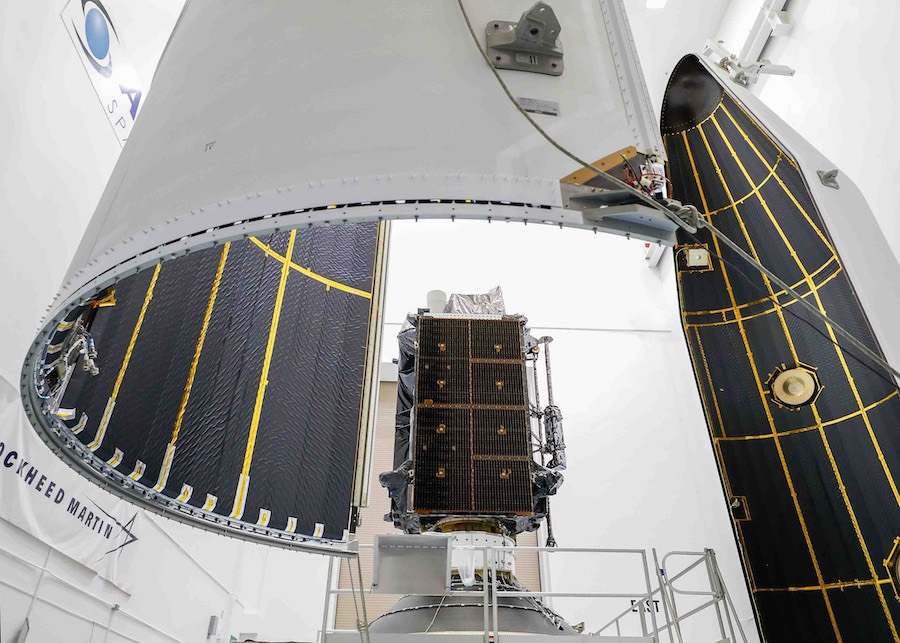
The GPS network provides positioning and timing services worldwide for military and civilian users, beaming signals relied upon by airliners, ATMs, drivers and smart bombs, among numerous other users.
“We’re committed to maintaining GPS as the gold standard of positioning, navigation and timing for all other systems to be measured against,” said Lt. Col. Maggie Sullivan, the Air Force’s GPS 3 program manager.
Thirty-one satellites are currently providing GPS navigation services.
The satellite launched Thursday is the second in a new generation of GPS satellites, providing more accurate navigation signals and boasting longer design lifetimes. The new GPS 3 satellites provide a new L1C civilian signal that is compatible with Europe’s Galileo network.
Other space-based navigation networks operated by Japan and China are also adopting similar compatible signals.
“Compared to the satellites in today’s constellation, this next generation of GPS satellites have three times greater accuracy, eight times improved anti-jam capabilities, and the new L1C civil signal compatible with other international satellite navigation systems like Galileo,” Caldwell told reporters before the launch.
“For those user equipment (providers) who elect to incorporate the L1C civil signal into their chipsets, those users will now have access not just to the GPS constellation but to Galileo and others who choose to then follow on with the L1C civil signal implementation,” Caldwell said. “So for users who are authorized to do that, instead of having just the legacy 31 points in the sky that you get from GPS, you’ll add on to it the ever-growing Galileo constellation.
“When it comes to finding out where you are, the more satellites you can see the better your position is.”
The first GPS 3-series satellite, named GPS 3 SV01, completed its post-launch checkout July 12 following an on-target deployment by a SpaceX Falcon 9 rocket last December, officials said. More testing is planned before GPS 3 SV01, named “Vespucci,” is ready to join the active GPS network.
“We’re excited now that the vehicle is through its on-orbit checkout and moving into the next phase of operational testing,” Caldwell said. “We expect that to begin later this year, and we’re looking forward to officially handing over the vehicle to the Air Force.”
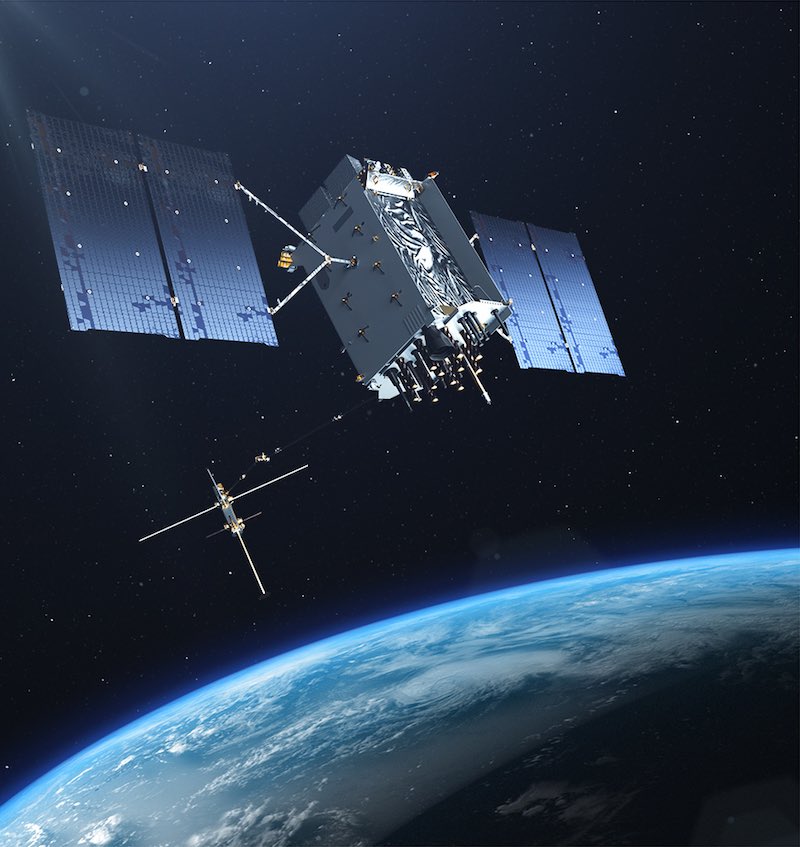
Like the previous line of Boeing-built GPS 2F satellites, all GPS 3-series spacecraft broadcast a dedicated L5 signal geared to support air navigation. The GPS 3 satellites also continue beaming an encrypted military-grade navigation signal known as M-code.
The M-code signal allows GPS satellites to broadcast higher-power, jam-resistant signals over specific regions, such as a military theater or battlefield. The capability provides U.S. and allied forces with more reliable navigation services, and could also allow the military to intentionally disrupt or jam civilian-grade GPS signals in a particular region, while the M-code signal remains unimpeded.
L3Harris Technologies builds the navigation payloads for the GPS 3 satellites.
Thursday’s launch was timed to place the GPS 3 SV02 spacecraft into Plane D, Slot 3 of the GPS constellation. That position is currently occupied by a GPS satellite launched in March 2003. Sullivan said the Air Force will make an “operational decision” on which aging GPS satellite, presumably in Plane D, the new spacecraft will replace.
The GPS satellites are spread among six orbital planes, each with four primary spacecraft, plus spares.
According to Sullivan, the GPS 3 SV02 spacecraft cost around $500 million. Future GPS 3 satellites will cost less, and officials target a cost of less than $200 million per spacecraft by time GPS 3 SV10 is ready for launch.
“The great thing about GPS is the volume of satellites,” Caldwell said. “You gain tremendous efficiencies when you have production volume, and you get commensurate cost reduction.”
Lockheed Martin is on contract with the Air Force to build up to 32 satellites, including 10 GPS 3 spacecraft and 22 upgraded GPS 3F satellites.
The next GPS mission, designated GPS 3 SV03 and nicknamed “Columbus,” is set for launch on a SpaceX Falcon 9 rocket in January. The satellite for that mission has already been declared available for launch, Air Force officials said.
Follow Stephen Clark on Twitter: @StephenClark1.


